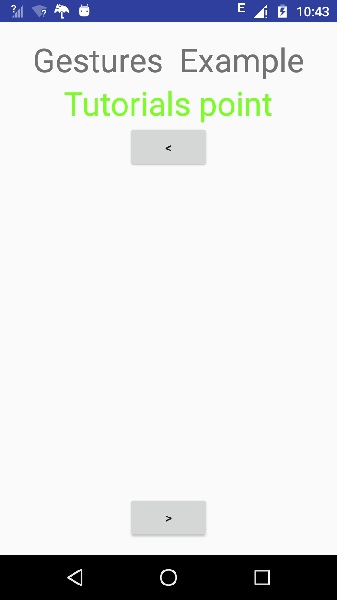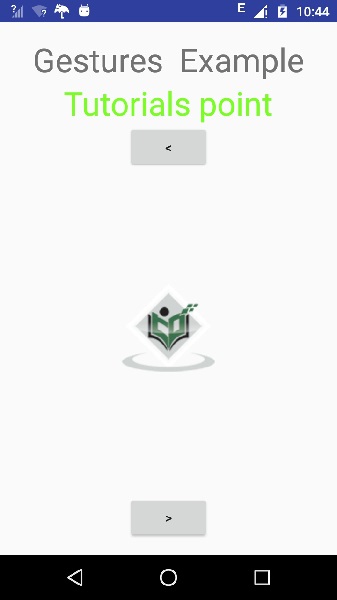Android-이미지 전환기
때로는 이미지가 화면에 갑작스럽게 나타나는 것이 아니라 한 이미지에서 다른 이미지로 전환 할 때 이미지에 일종의 애니메이션을 적용하고 싶을 때가 있습니다. 이것은 ImageSwitcher의 형태로 안드로이드에서 지원됩니다.
이미지 스위처를 사용하면 화면에 나타나는 방식을 통해 이미지에 몇 가지 전환을 추가 할 수 있습니다. 이미지 전환기를 사용하려면 먼저 해당 XML 구성 요소를 정의해야합니다. 구문은 다음과 같습니다.
<ImageSwitcher
android:id="@+id/imageSwitcher1"
android:layout_width="wrap_content"
android:layout_height="wrap_content"
android:layout_centerHorizontal="true"
android:layout_centerVertical="true" >
</ImageSwitcher>이제 Java 파일에 ImageSwithcer의 인텐스를 만들고이 XML 구성 요소에 대한 참조를 얻습니다. 구문은 다음과 같습니다.
private ImageSwitcher imageSwitcher;
imageSwitcher = (ImageSwitcher)findViewById(R.id.imageSwitcher1);다음으로 ViewFactory 인터페이스를 구현하고 imageView를 반환하는 구현되지 않은 메서드를 구현해야합니다. 구문은 다음과 같습니다.
imageSwitcher.setImageResource(R.drawable.ic_launcher);
imageSwitcher.setFactory(new ViewFactory() {
public View makeView() {
ImageView myView = new ImageView(getApplicationContext());
return myView;
}
}마지막으로해야 할 일은 ImageSwitcher에 애니메이션을 추가하는 것입니다. 정적 메소드 loadAnimation을 호출하여 AnimationUtilities 클래스를 통해 Animation 클래스의 객체를 정의해야합니다. 구문은 다음과 같습니다.
Animation in = AnimationUtils.loadAnimation(this,android.R.anim.slide_in_left);
imageSwitcher.setInAnimation(in);
imageSwitcher.setOutAnimation(out);setInAnimaton 메서드는 화면에 개체가 나타나는 애니메이션을 설정하는 반면 setOutAnimation은 그 반대입니다. loadAnimation () 메서드는 애니메이션 객체를 만듭니다.
이러한 메서드 외에도 ImageSwitcher 클래스에 정의 된 다른 메서드가 있습니다. 그들은 아래에 정의되어 있습니다-
| Sr. 아니요 | 방법 및 설명 |
|---|---|
| 1 | setImageDrawable(Drawable drawable) 이미지 스위처로 이미지를 설정합니다. 이미지는 비트 맵 형식으로 전달됩니다. |
| 2 | setImageResource(int resid) 이미지 스위처로 이미지를 설정합니다. 이미지는 정수 ID 형식으로 전달됩니다. |
| 삼 | setImageURI(Uri uri) 이미지 스위처로 이미지를 설정합니다. 이미지는 URI 형식으로 전달됩니다. |
| 4 | ImageSwitcher(Context context, AttributeSet attrs) 메소드에 전달 된 일부 속성이 이미 설정되어있는 이미지 전환기 객체를 반환합니다. |
| 5 | onInitializeAccessibilityEvent (AccessibilityEvent event) 이벤트 소스 인이 View에 대한 정보로 AccessibilityEvent를 초기화합니다. |
| 6 | onInitializeAccessibilityNodeInfo (AccessibilityNodeInfo info) 이 뷰에 대한 정보로 AccessibilityNodeInfo를 초기화합니다. |
예
아래 예제는 비트 맵에 대한 일부 이미지 전환 효과를 보여줍니다. 이미지에 애니메이션 효과를 볼 수있는 기본 응용 프로그램을 만듭니다.
이 예제를 실험하려면 실제 기기에서 실행해야합니다.
| 단계 | 기술 |
|---|---|
| 1 | Android 스튜디오 IDE를 사용하여 com.example.sairamkrishna.myapplication 패키지 아래에 Android 애플리케이션을 만듭니다. |
| 2 | src / MainActivity.java 파일을 수정하여 필요한 코드를 추가합니다. |
| 삼 | res / layout / activity_main을 수정하여 각 XML 구성 요소를 추가하십시오. |
| 4 | 애플리케이션을 실행하고 실행중인 Android 기기를 선택하고 여기에 애플리케이션을 설치하고 결과를 확인합니다. |
다음은 수정 된 주요 활동 파일의 내용입니다. src/MainActivity.java.
아래 코드에서 tp 과 abc tutorialspoint.com의 로고를 나타냅니다.
package com.example.sairamkrishna.myapplication;
import android.app.Activity;
import android.app.ActionBar.LayoutParams;
import android.os.Bundle;
import android.view.View;
import android.widget.Button;
import android.widget.ImageSwitcher;
import android.widget.ImageView;
import android.widget.Toast;
import android.widget.ViewSwitcher.ViewFactory;
public class MainActivity extends Activity {
private ImageSwitcher sw;
private Button b1,b2;
@Override
protected void onCreate(Bundle savedInstanceState) {
super.onCreate(savedInstanceState);
setContentView(R.layout.activity_main);
b1 = (Button) findViewById(R.id.button);
b2 = (Button) findViewById(R.id.button2);
sw = (ImageSwitcher) findViewById(R.id.imageSwitcher);
sw.setFactory(new ViewFactory() {
@Override
public View makeView() {
ImageView myView = new ImageView(getApplicationContext());
myView.setScaleType(ImageView.ScaleType.FIT_CENTER);
myView.setLayoutParams(new
ImageSwitcher.LayoutParams(LayoutParams.WRAP_CONTENT,
LayoutParams.WRAP_CONTENT));
return myView;
}
});
b1.setOnClickListener(new View.OnClickListener() {
@Override
public void onClick(View v) {
Toast.makeText(getApplicationContext(), "previous Image",
Toast.LENGTH_LONG).show();
sw.setImageResource(R.drawable.abc);
}
});
b2.setOnClickListener(new View.OnClickListener() {
@Override
public void onClick(View v) {
Toast.makeText(getApplicationContext(), "Next Image",
Toast.LENGTH_LONG).show();
sw.setImageResource(R.drawable.tp);
}
});
}
}다음은 xml의 수정 된 내용입니다. res/layout/activity_main.xml.
<?xml version="1.0" encoding="utf-8"?>
<RelativeLayout
xmlns:android="http://schemas.android.com/apk/res/android"
xmlns:tools="http://schemas.android.com/tools"
android:layout_width="match_parent"
android:layout_height="match_parent"
android:paddingLeft="@dimen/activity_horizontal_margin"
android:paddingRight="@dimen/activity_horizontal_margin"
android:paddingTop="@dimen/activity_vertical_margin"
android:paddingBottom="@dimen/activity_vertical_margin"
tools:context=".MainActivity">
<TextView android:text="Gestures Example"
android:layout_width="wrap_content"
android:layout_height="wrap_content"
android:id="@+id/textview"
android:textSize="35dp"
android:layout_alignParentTop="true"
android:layout_centerHorizontal="true" />
<TextView
android:layout_width="wrap_content"
android:layout_height="wrap_content"
android:text="Tutorials point"
android:id="@+id/textView"
android:layout_below="@+id/textview"
android:layout_centerHorizontal="true"
android:textColor="#ff7aff24"
android:textSize="35dp" />
<ImageSwitcher
android:layout_width="wrap_content"
android:layout_height="wrap_content"
android:id="@+id/imageSwitcher"
android:layout_below="@+id/textView"
android:layout_centerHorizontal="true"
android:layout_marginTop="168dp" />
<Button
android:layout_width="wrap_content"
android:layout_height="wrap_content"
android:text="@string/left"
android:id="@+id/button"
android:layout_below="@+id/textView"
android:layout_centerHorizontal="true" />
<Button
android:layout_width="wrap_content"
android:layout_height="wrap_content"
android:text="@string/right"
android:id="@+id/button2"
android:layout_alignParentBottom="true"
android:layout_alignLeft="@+id/button"
android:layout_alignStart="@+id/button" />
</RelativeLayout>다음 내용은 Strings.xml 파일.
<resources>
<string name="app_name">My Application</string>
<string name="left"><![CDATA[<]]></string>
<string name="right"><![CDATA[>]]></string>
</resources>다음 내용은 AndroidManifest.xml 파일.
<?xml version="1.0" encoding="utf-8"?>
<manifest xmlns:android="http://schemas.android.com/apk/res/android"
package="com.example.sairamkrishna.myapplication"
<application
android:allowBackup="true"
android:icon="@drawable/ic_launcher"
android:label="@string/app_name"
android:theme="@style/AppTheme" >
<activity
android:name="com.example.sairamkrishna.myapplication.MainActivity"
android:label="@string/app_name" >
<intent-filter>
<action android:name="android.intent.action.MAIN" />
<category android:name="android.intent.category.LAUNCHER" />
</intent-filter>
</activity>
</application>
</manifest>방금 수정 한 애플리케이션을 실행 해 보겠습니다. 나는 당신이 당신의AVD환경 설정을하는 동안. Android 스튜디오에서 앱을 실행하려면 프로젝트의 활동 파일 중 하나를 열고


이제 장치 화면을 보면 두 개의 버튼이 표시됩니다.
이제 오른쪽 화살표 위쪽 버튼을 선택하십시오. 이미지가 오른쪽에서 나타나고 왼쪽으로 이동합니다. 아래에 나와 있습니다-

이제 아래 버튼을 탭하면 일부 전환과 함께 이전 이미지로 돌아갑니다. 아래에 나와 있습니다-
